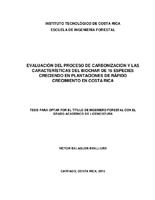Mostrar el registro sencillo del ítem
Evaluación del proceso de carbonización y las características del biochar de 16 especies creciendo en plantaciones de rápido crecimiento en Costa Rica
| dc.contributor.advisor | Moya-Roque, Róger | es |
| dc.contributor.author | Balaguer-Benlliure, Víctor | |
| dc.date.accessioned | 2019-09-25T22:58:01Z | |
| dc.date.available | 2019-09-25T22:58:01Z | |
| dc.date.issued | 2019 | |
| dc.identifier.uri | https://hdl.handle.net/2238/10833 | |
| dc.description | Trabajo Final de Graduación (Licenciatura en Ingeniería Forestal) Instituto Tecnológico de Costa Rica, Escuela de Ingeniería Forestal, 2019. | es |
| dc.description.abstract | En la actualidad hay un marcado interés en buscar procesos para aumentar la densidad energética de los materiales ya existentes y el proceso por pirólisis es uno de esos. El presente estudio determinó el rendimiento en producción de carbón y las características físico-químicas (densidad, dureza, contenido de humedad, poder calorífico, cenizas y volátiles y componentes químicos mediante un análisis elemental de contenido en carbono, nitrógeno, hidrógeno, azufre y oxígeno) del carbón producido a partir de 16 maderas de especies de rápido crecimiento utilizadas para reforestación en Costa Rica. Los resultados mostraron que el rendimiento varió entre 40.73% (Enterolobium cyclocarpum) y 23,88% (Acacia mangium). Por otro lado, en las propiedades del carbón se determinó que el poder calorífico varió de 24,30 MJ/kg a 32,10 MJ/kg, mientras que las densidades del carbón variaron entre 0,15 g/cm3 y 0,40 g/cm3. En el contenido de humedad del carbón se observó valores de 2,66% a 7,92%. Para la resistencia en compresión paralela a fibra se determinó que la más baja fue de 19,07 kg/cm2 y el valor más alto fue de 82,92 kg/cm2. Las cenizas obtenidas variaron de 0,26% a 6,36%, mientras que para el contenido de la fracción de volátiles fue de 24,16% a 33,34%. Finalmente, el índice de combustibilidad fue el resultado con mayor variación de valores, oscilando entre 41,00 y 4 225,21. Cupressus lusitanica resultó ser la especie con el mayor potencial energético por su relación entre alto poder calorífico y densidad, y su bajo porcentaje en cenizas y contenido de humedad. Se concluyó que teniendo en cuenta las propiedades físico-químicas del carbón producido este se puede considerar como una alternativa para la comercialización de los residuos de las especies utilizada en la reforestación comercial en Costa Rica. | es |
| dc.description.abstract | At present there is a marked interest in looking for processes to increase the energy density of existing materials and the process by pyrolysis is one of those. In the present study, it determined the yield in coal production and the physical-chemical characteristics (density, hardness, moisture content, calorific value, ash and volatiles and chemical components through an elemental analysis of carbon, nitrogen, hydrogen, sulfur and oxygen) of the coal produced from 16 woods of fast-growing species used for reforestation in Costa Rica. The results showed that the yield varied between 40.73% (Enterolobium cyclocarpum) and 23.88% (Acacia mangium). On the other hand, in the properties of coal it was determined that the calorific value varied from 24.30 MJ / kg to 32.10 MJ / kg, while the coal densities ranged from 0.15 g/cm3 to 0.40 g/cm3. In the moisture content of the coal, values from 2.66% to 7.92% were observed. For the compression strength parallel to the fiber was determined that the lowest was 19.07 kg / cm2 and the highest value was 82.92 kg / cm2. The ashes obtained varied from 0.26% to 6.36%, while for the content of the volatile fraction it was from 24.16% to 33.34%. Finally, the combustibility index was the result with the greatest variation in values, ranging from 41.00 to 4.225.21. Cupressus lusitanica was the species with the highest energy potential due to its relationship between high calorific value and density, and its low percentage of ash and moisture content. It was concluded that taking into account the physico-chemical properties of the carbon produced this can be considered as an alternative for the commercialization of the waste of the species used in commercial reforestation in Costa Rica. | es |
| dc.language.iso | spa | es |
| dc.publisher | Instituto Tecnológico de Costa Rica | es |
| dc.rights | acceso abierto | es |
| dc.rights.uri | https://creativecommons.org/licenses/by-nc-sa/4.0/ | * |
| dc.subject | Biomasa | es |
| dc.subject | Bioenergía | es |
| dc.subject | Cambio climático | es |
| dc.subject | Carbón vegetal | es |
| dc.subject | Energía renovable | es |
| dc.subject | Pirólisis | es |
| dc.subject | Biomass | es |
| dc.subject | Climate change | es |
| dc.subject | Research Subject Categories::FORESTRY, AGRICULTURAL SCIENCES and LANDSCAPE PLANNING::Area technology::Remote sensing | es |
| dc.subject | Pyrolysis | es |
| dc.subject | Bioenergy | es |
| dc.title | Evaluación del proceso de carbonización y las características del biochar de 16 especies creciendo en plantaciones de rápido crecimiento en Costa Rica | es |
| dc.type | proyecto fin de carrera | es |



